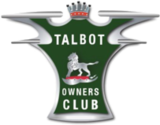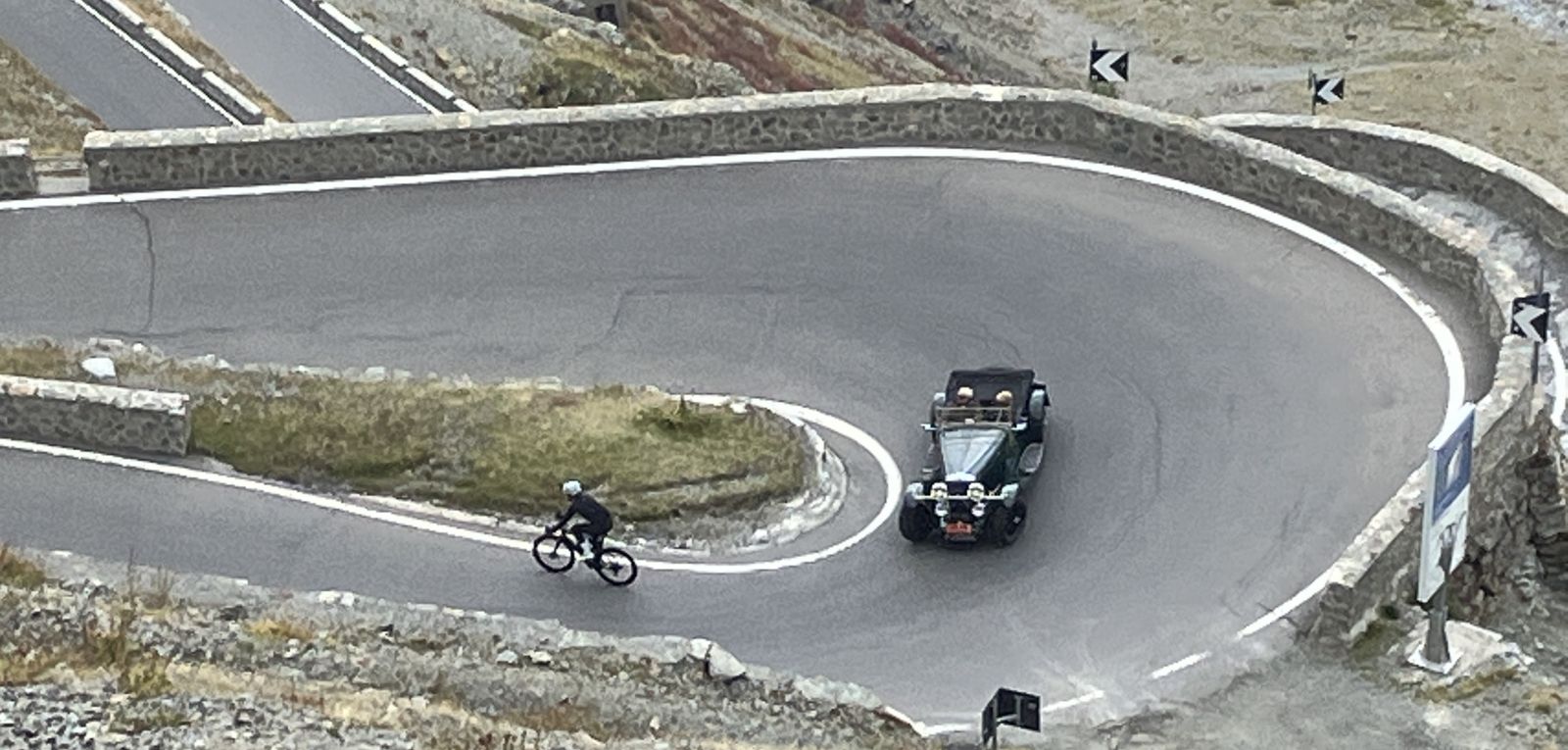1932 Alpine Trial 90th Anniversary Celebration Tour 10th Sep 2022
The 1932 International Alpine Trial was a hugely important event in the motoring calendar. British manufacturers took advantage of the opportunity to display the success of their cars to a much wider international audience, and in 1932 the Talbot and Riley teams both won a Coupe des Alpes. In the Talbots’ case, this was achieved without the loss of a single penalty mark, the first time in the history of the event that this had been accomplished.
It was on the evening of the fifth of August 1932 that the following telegram was received at Fox and Nicholl offices:
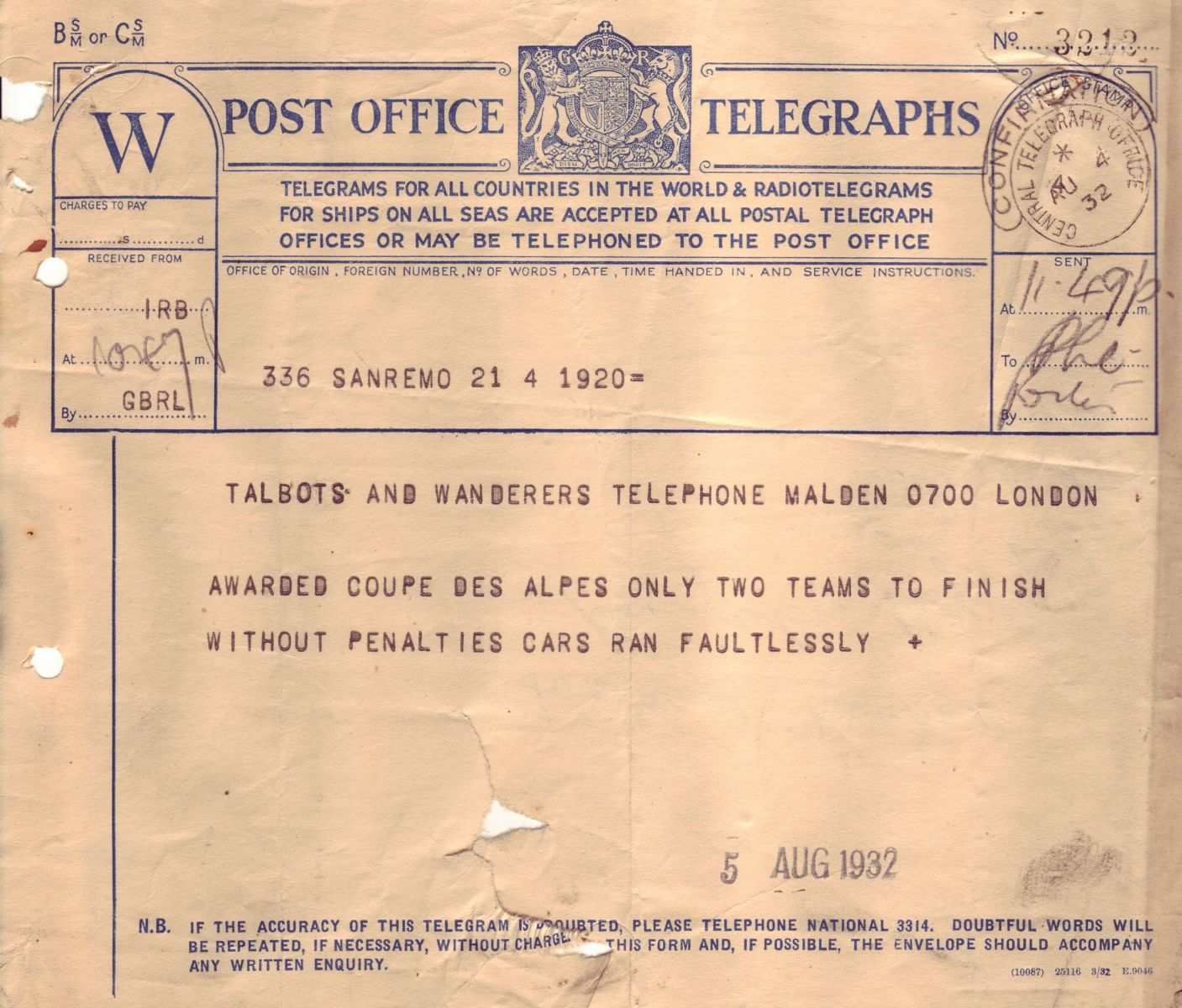
That major achievement by the 1932 team of 105s was the excuse, if we needed one, for our celebration that took place from 10th – 18th September. Talbots were built for and tested in the Alps, and there are some of us who also believe that the Alps were specifically built as a Talbot playground. A smaller group than on previous anniversary celebrations, but no less enthusiastic, headed south to find the high passes.
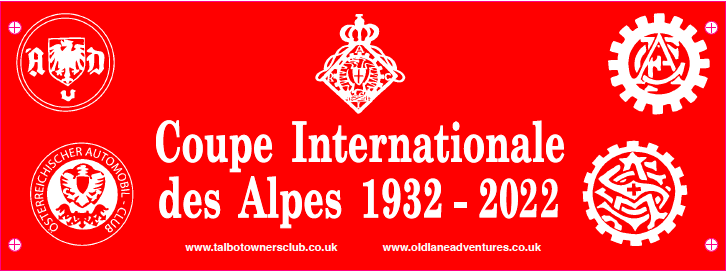
Equipped with replica rally plates to the same design used in 1932, five Talbot owners and four other enthusiastic drivers set out. Those driving Barlby Road chariots were James Tibbitts and Tim Palmer, Rob May and Tim Houlding, and ourselves, David Thomson with the arch-Talboteer Nick Ward alongside. The other TOC members who on this occasion chose to drive different marques were Ian Polson and David Jones in Ian’s beautifully restored Bristol 403, and Fred and Tina Herzog, forsaking their 105 in exchange for the muscle power of their bright red Allard. The équipe was completed by two Jaguar E Types and two Morgans, all cars comfortably able to keep up with the pre-war superiority of the Talbots.
Our purpose, while not following the 1932 route in its entirety, was to experience the thrill of dramatic Alpine motoring, through countryside that in many ways remains unchanged since the PJ cars showed the world how to tackle Alpine challenges successfully.
The planned route took us south through France, across the Vosges Mountains of Alsace to the Black Forest on the eastern banks of the Rhine. From there we headed south and east, across Switzerland to the Austrian Arlberg, stopping for two nights in Lech, before heading south and over the mighty Stelvio Pass to the duty-free haven of Livigno, again for a two-night stop. Our final two days took us over an abundance of high passes, with a final celebration in Meiringen, at the foot of the spectacular Grimsel and Susten Passes.
Nick Ward, travelling with me, takes up the early part of the story:
An early start put us on the 10am ferry to Calais where we met up with Iain and his Morgan. France greeted us with fair weather and clear roads - what more could you ask for? We made our way swiftly, as always with David in his Talbot, through the French countryside. A few rain clouds appeared up ahead but we seemed to miss them all – until the rain hit us! It came down by the bucketful – like driving into a torrential waterfall! As there was a village up ahead, we went on in the hope of finding a sheltered spot to put the hood up. No luck, so we got out of the car, put the tonneau on and huddled under an umbrella.
After 15 minutes, with no let-up, there were rivers running down the road. Eventually it eased, and Iain and the Morgan arrived equally wet through. We got the hood up and headed off to our hotel where all had arrived. The mixture of cars made a fine show in the carpark. After enjoying a warming shower and dry clothes, life became much better and we met new and old friends over a superb dinner.
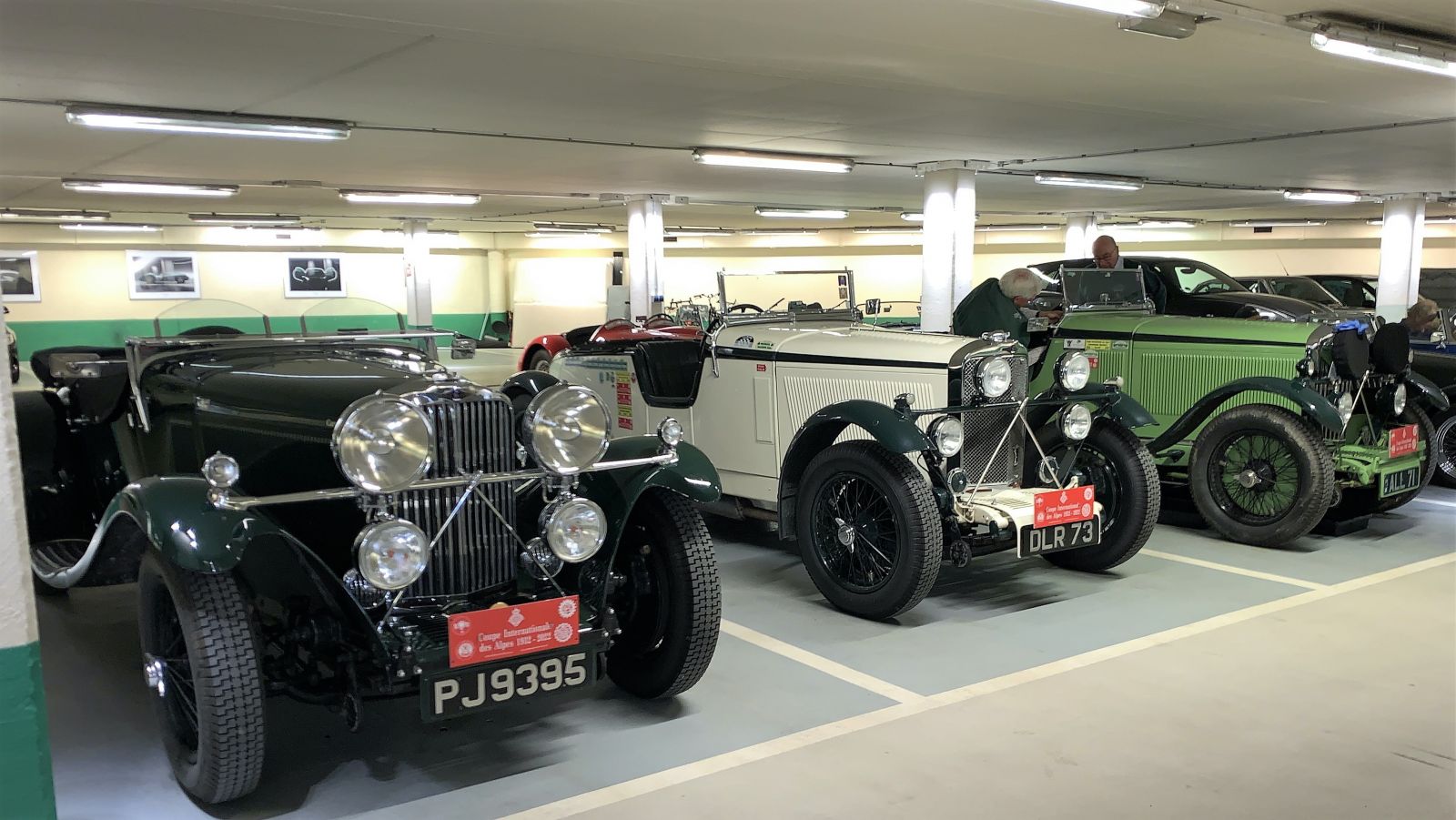
Sunday brought a fine day, so good time was made across northern France to the Rhine. We hit our first pass, crossing the Vosges by way of Col de la Schlucht. We had all been warned by Fred Herzog to buy fuel in France before entering Germany as it was 50 cents cheaper a litre. Fuelled up with 98 octane, we crossed the Rhine, with views of the Black Forest up ahead, and arrived at our overnight hotel which provided another magnificent meal. David decided to bring his seat cushion into the hotel to try and dry it as he had been suffering from rising damp all day.
Monday gave us a change from the plains of northern France with our first serious mountains, enjoyed by everyone except Ian Polson who had filled up with some very cheap petrol, or something he thought resembled petrol, which his Bristol found nearly indigestible. A lovely day’s motoring brought us to the Austrian village of Lech and yet more fabulous food.
Our base in Lech for two nights was the five-star Hotel Arlberg, and on Tuesday we had planned some exciting routes in the Austrian Alps. We did have fun, but it’s the season for major roadworks before winter, and sadly the Fern Pass was closed with no easy alternative. Our sights were set on more rewarding driving on Wednesday, when James Tibbitts picks up the baton:
Today we leave Lech and head for our next hotel in Livigno, but the Hotel Arlberg in Lech is not a place you hurry away from. The owner is an old car enthusiast and has been hugely welcoming to us. Last time we were here there were some building works in progress, now complete, having added an outdoor heated pool and beautiful gardens to this lovely five-star hotel. And so, a leisurely start after breakfast and a leisurely route to follow; first south through Zurs and through the tunnels and galleried sections protecting the road from rock and snow falls and then east towards Innsbruck. Then south again along the beautiful valley of the River Inn past Nauders and along the shore of Lake Resia.
Now we have met up with David Thomson in DLR73, who has doubtless arrived here by a more adventurous route, and we head south west towards Gomagoi and the main reason for selecting this route. Many readers of this piece will be far more familiar with the Stelvio than I am, and perhaps may also recognise that it is somewhat of a “marmite” pass. Some of our party have planned to avoid it and have sought out another way to Livigno, intending to approach it from the north through the Munt La Schera Tunnel, only to find that closed, and more roadworks, necessitating a longer detour around through Pontresina and over the Bernina pass to approach Livigno from the south.
For us, though, the Stelvio exerts a strange compulsive call. At 2,757 metres (2,760 if you believe the sign at the top of the pass) it is the second highest paved Alpine pass, just 13 metres short of the Col de L’Iseran. The Cîme de la Bonnette claims 2,802 metres but isn’t really a pass at all, just a loop from the top of the Col de la Bonnette (2,715 metres) built for seemingly no reason at all, save to claim the highest crown.
To appreciate the Stelvio you have to approach it from the east. There are 48 hairpins in all, but the real climb starts after Trafoi with the 44 hairpins to the summit. Although the season is now past its busiest, there are still a lot of motorbikes and cyclists in both directions, requiring great care as many of the turns can only be achieved in one by using most of the available road. The 110 engine in DLR73 has just that bit more power than the 3 litre 105 engine and on the straight steep sections David slowly opens a gap between us before we catch him again, courtesy of a camper van crawling its way upwards and refusing to accept that it should give way and let him past. We can feel the fumes rising above DLR73 and not just from the engine!
Eventually the van relents and we pass by and the gap slowly opens again before we meet at the top. After parking, we walk back a few metres to watch for others and see Rob May cruising serenely around the last few bends in his 105 to join us at the top. The view back down the pass from here is very special and, if you haven’t been there, you can get a sense of that from looking on Google Street View. Some passes have a coffee shop at the top, but the Stelvio has a whole tourist village perched at the summit, and coffee and strudel at the Hotel Passo Stelvio is our reward, giving drivers time to recover from the effort of hauling the cars around all those turns.
Then the run down to Bormio, and back up again, and through the customs post into the Livigno duty-free area; more petrol stations than you might think reasonable for a small alpine town, but catering for drivers, especially from nearby Switzerland, who come to fill their tanks with the cheaper fuel. The petrol we got claimed to be 100 octane but the car did not react well to it, a condition rectified subsequently when we found some Shell V Power.
Livigno served as the base for those celebrating the 50th anniversary of the 1932 Coupe des Alpes in 1982, so it was fitting that we return here 40 years later. And has anyone mentioned it was a duty-free zone? It’s only a few kilometres up the Bernina Pass from St Moritz, where the 1932 team had their enforced rest day before heading back to the hills. And so with us – Fred and Tina Herzog take up the account of the next part of our adventure:
Friday 16th September – 270 kms / 170 mls and 6 Alpine passes
Our final breakfast in Livigno saw us intensely studying and comparing a multitude of weather apps – to find the best (“driest”) way to our destination in Meiringen (CH). Conversations climaxed at “you need to be at Disentis around 14:35 hrs – there is dry zone of about 30 mins over the Oberalp pass.”
The majority of crews, including us, took the “northerly” route: out of Livigno (over the Forcola di Livigno 2.315 m) into Switzerland, over the Bernina pass (2.328 m) – passing the still impressive Morteratsch glacier (pictured)– and leaving Engadina over the Albula pass (2312 m). Down the Posterior Rhine (“Hinterrhein”) and up the Anterior Rhine (“Vorderrhein”) we climbed steadily towards and over the Oberalp pass (2.044 m). Passing Andermatt quickly to run over the passes of Furka (2.429 m) and a very foggy Grimsel (2.165 m) to get down into Meiringen. Fortunately, the weather proved to be much better than forecast!
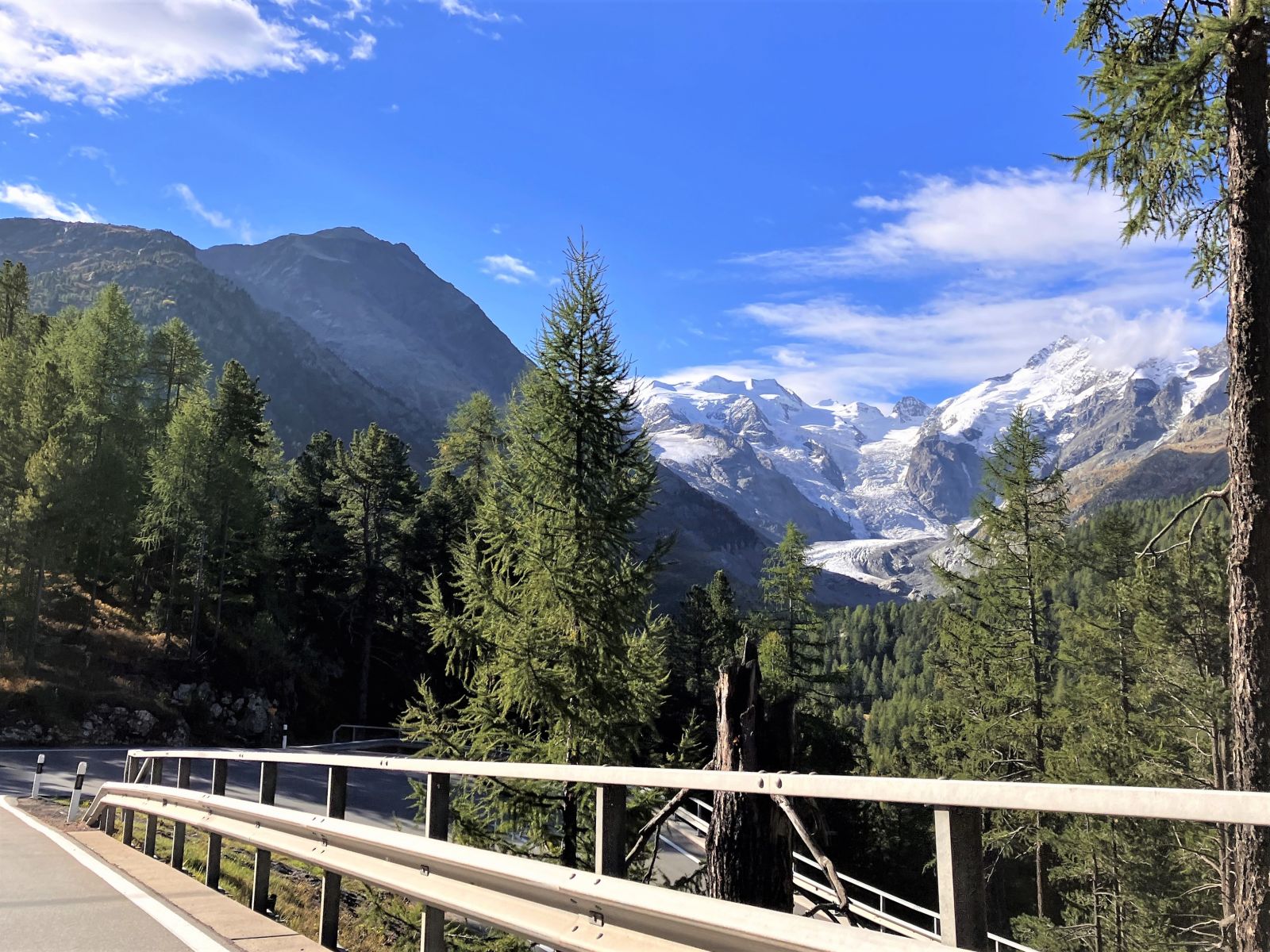
At the bar, and over a fabulous dinner, different routes were compared. Another fabulous day!
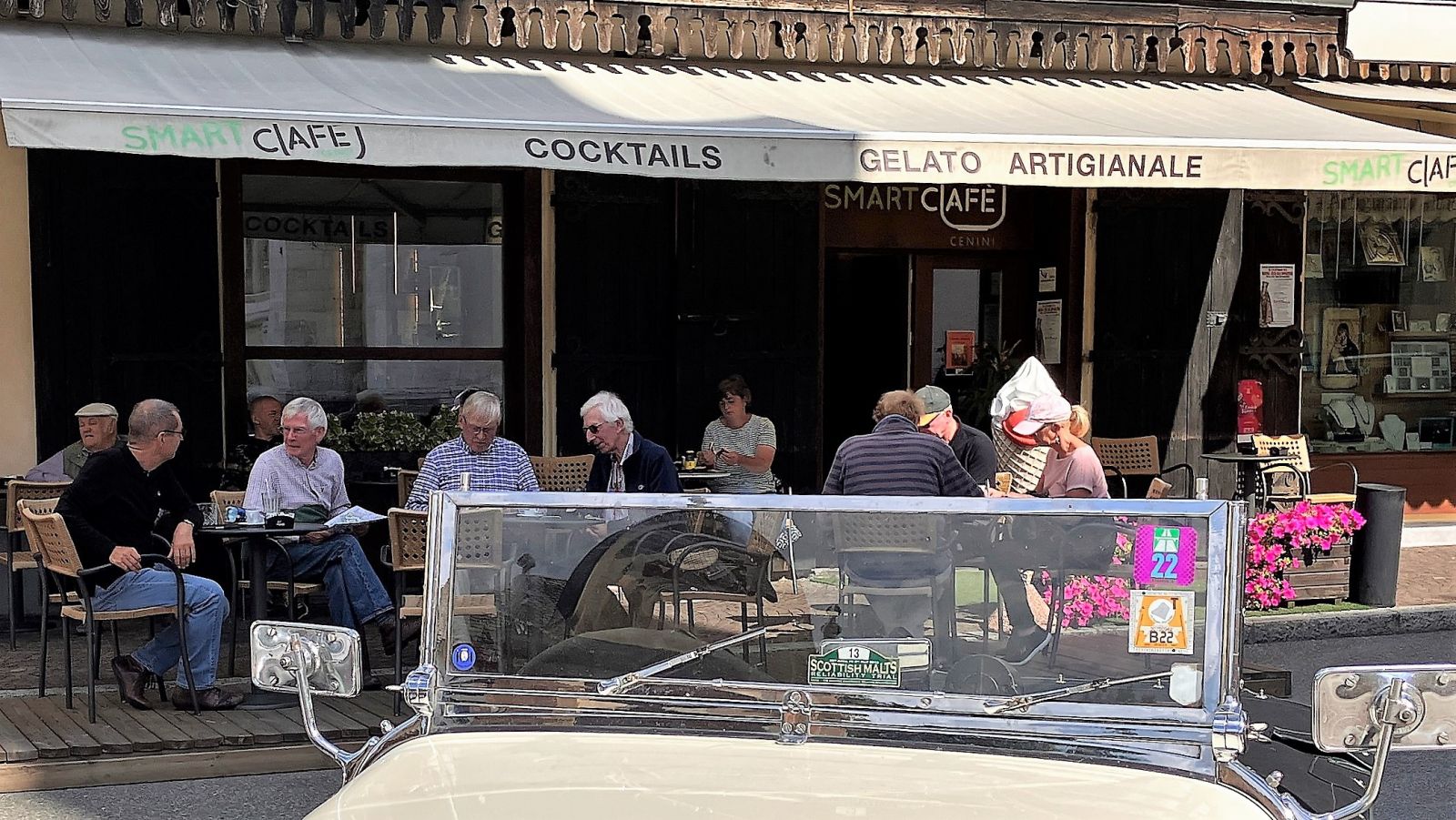
Saturday 17th September - 10 kms / 6 mls by foot and a gorge instead of passes.
The teams approached rain and fog around Meiringen differently: While the “must-drives” ran up the Grimsel pass – to find the upper section closed due to snow-covered roads, others took it more leisurely by motoring along the Brienzer See into Interlaken.
A small group went for folklore and nature. By train to the nearby village of Innertkirchen (where Grimsel and Furka roads start) to spectate the “Alpabfahrt” scheduled for this very day. It is the once-a-year concerted drive of the decorated cattle down from the alpine pastures to their barns in the valley.
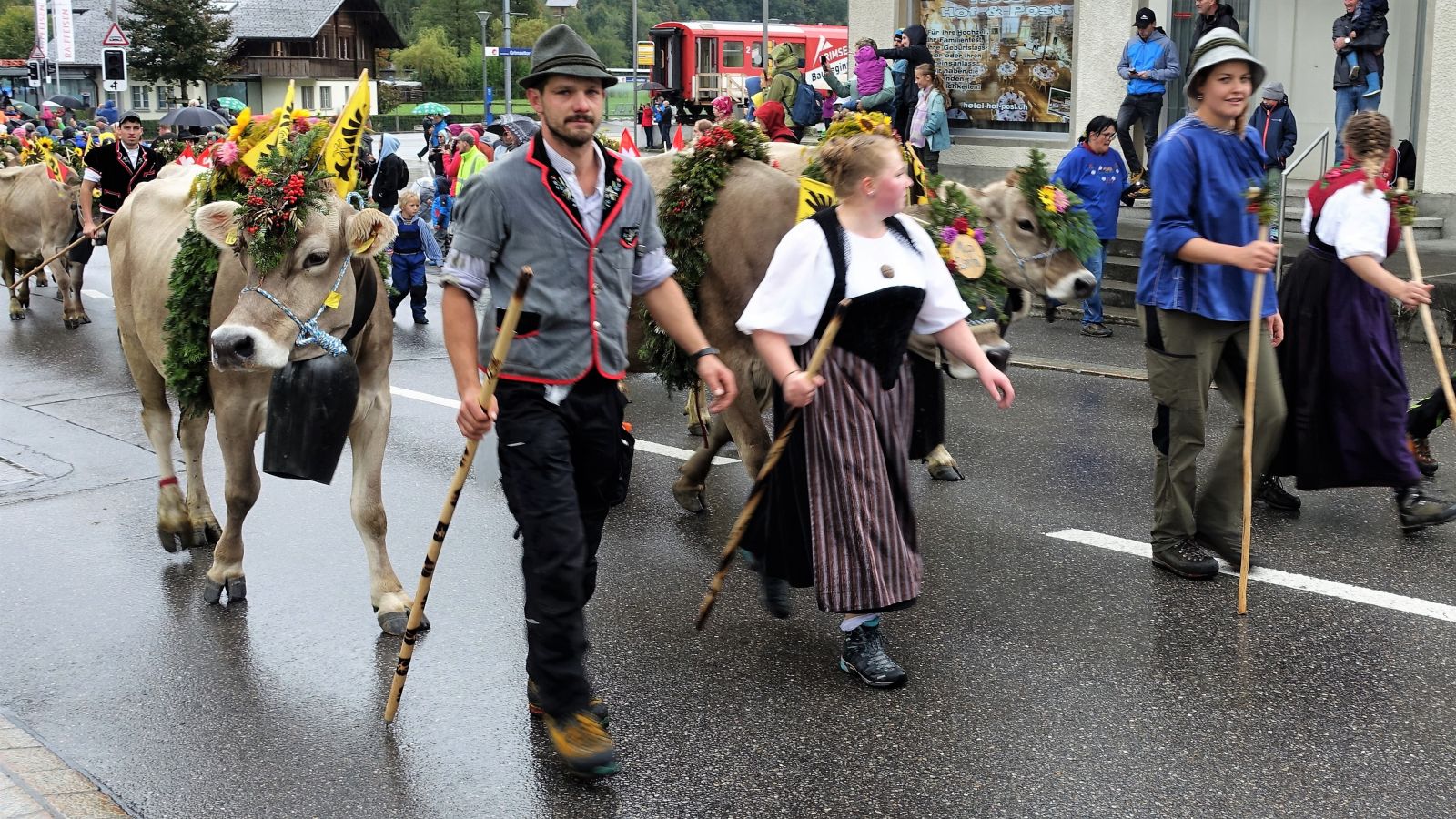
Locals like this festival to meet friends – and have a chat over beer and sausage. So did we, admiring the procession and soon retiring to the festival tent for beer and sausage – and mix with the locals.
Back to Meiringen - by foot through the 2 miles long Aare gorge, formed over thousands of years by the Aare Glacier; quiet splashing, loud roaring, glacial water in glacial mills, limestone formations – experienced through tunnels and over footbridges.
An entertaining day “Swiss-style”!
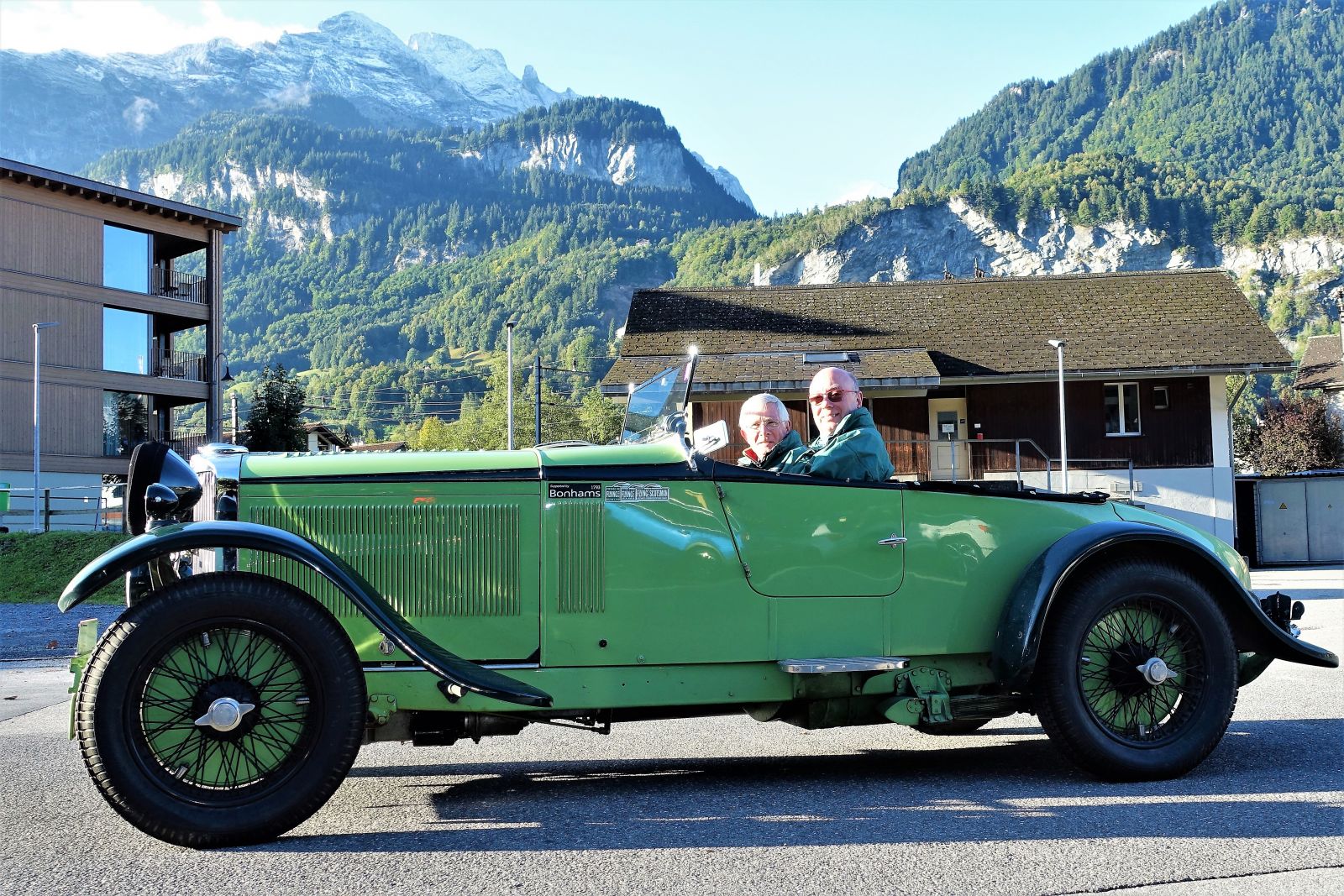
And finally, two reflections. One from Rob May, a most experienced Alpine Talboteer, and one from his co-pilot, Tim Houlding. Rob first:
Since 2007 I have travelled on a number of these 1932 Alpine Trial Anniversary runs to the Alps with David Thomson. All have been most enjoyable: beautiful countryside, superb hotels, and excellent company. This year we were travelling with many old friends in their Morgans, Jaguar E Types, and Ian Polson, who graced us with his delightful Bristol 403. In truth it would have been nice to see more Talbots on the tour, but those present performed with the expected reliability. One should not forget the help and advice of the locals from that part of the world; Fred and Tina Herzog. They readily supplied additional information about our routes, and an accurate daily weather forecast of what we could expect for the day ahead. On this tour they left their Talbot 105 at home, and travelled with us in a bright red/orange Allard J2, complete with its "rorty" Cadillac engine. A most photogenic car with its decidedly curvy "derriere", and a navigator in a period, white crash helmet!
Some of us travelled independently each day, so I cannot recall what mischiefs the other Talbots experienced. However, James did witness my hasty uphill overtaking of a loaded farm tractor and trailer in the face of distant, oncoming moderns. He mentioned later "that I probably required a change of trousers that night". (Not true James. Everything was under control - just!) On another occasion, rounding a blind bend in the mountains, I quickly happened upon an accident which had backed cars up to the other side of the aforementioned bend. With a screeching of locked front tyres, my Talbot brakes pulled up square and true. My navigator's comment beside me was that “a Bentley would never have stopped in time"!
This year I was unable to be bring Jenny, but I was joined by a friend of some years, Tim Houlding. Tim is a renowned W O Bentley aficionado. Having rebuilt two three litre and one four-and-a-half-litre motor cars. He is known and respected throughout the Bentley world.
And then from Tim, experiencing his first Alpine adventure in a Talbot:
Rob May very kindly asked me to join him in his 1934 105. I can say that it was with some excitement that we ventured forth. I knew Rob to be a meticulous engineer, so I felt no trepidation.
I am used to the somewhat agricultural, but robust, ride of the vintage Bentley. It became obvious very quickly that the Roesch Talbot is a very sophisticated machine. Its road manners are impeccable for a nearly ninety-year-old vehicle. Its steering, brakes and suspension are truly remarkable, with plenty of power and torque for a three-litre engine and 4.3 back-axle ratio. Rob has recreated the extremely well-balanced and unpretentious Vanden Plas four-seater coachwork which proved very comfortable and provided good protection against all climates, including our very wet run through England on our first day.
Suffice to say that meeting up with other participants was an immediate and sustained pleasure. I have rarely encountered such an intelligent and interesting group of enthusiasts. David Thomson's planning and execution of the Tour was exceptional and I had the special excitement of storming "The Stelvio" with him in his 105.
David made available to us some of the period write-ups on the faultless Talbot victory in 1932. I was amused to read (it's obviously a very well-kept secret amongst the Bentley crowd!) that the Kidston ex-Le Mans Bentley 3 litre was also entered, but failed early on owing to clutch failure. Such is the penalty of weight and a very unsympathetic close-ratio crash gearbox! In addition, the latest edition of Benjafield's Racing Club gazette, a club largely inhabited by Bentleymen, contained three colour photos of Talbots at the 2022 Le Mans Classic - JJ93, BGH21 and GO53. The word about Talbot excellence is getting around!
So, in summary, a fabulous Alpine Tour in the company of inspiring venerable cars and delightful runners and riders. Thank you one and all, with special homage to our Tourmeister, David, and my unflappable host, Rob May.
And so ended the latest reminder of how wonderfully designed our cars are for the pleasures of Alpine Motoring. It’s just ten years to go until 2032, the centenary of the 1932 Alpine Trial – it may pay to get your name down early for that celebration too, whoever may be the organiser!
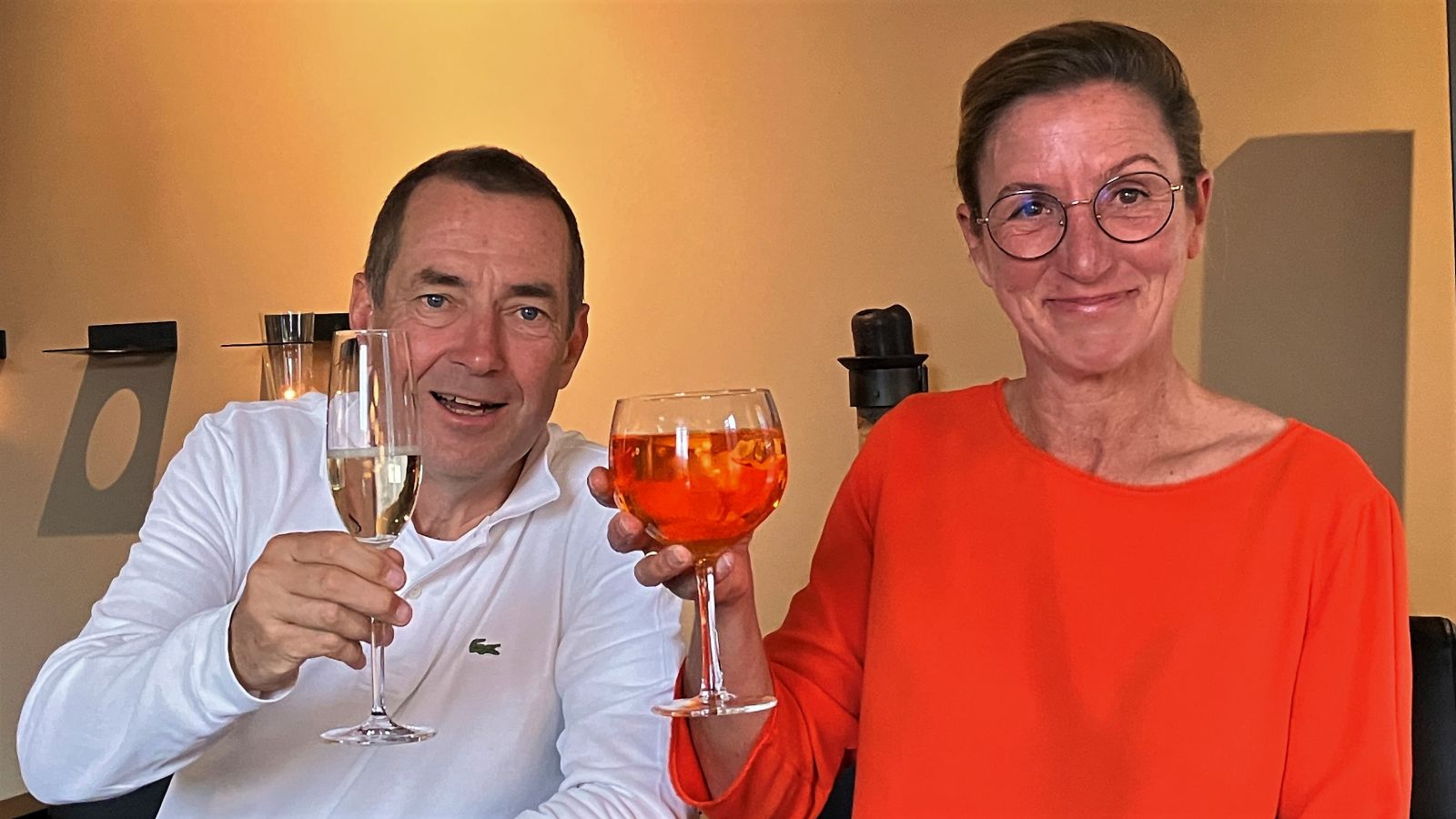
THE TALBOT OWNERS CLUB MAGAZINE
The Talbot Owners Club magazine is published bi-monthly and contains news, updates and informative articles. It is edited by club secretary David Roxburgh.
GO TO DOWNLOADS
TALBOT OWNERS CLUB MEMBERSHIP
The essence of the Club is to ensure that members meet and enjoy themselves; the Club is open and democratic, dialogie is encouraged. It is for people of all ages who like Talbot cars and want to enjoy the company of like-minded people and also to support current Talbot involvement in historic competition.
